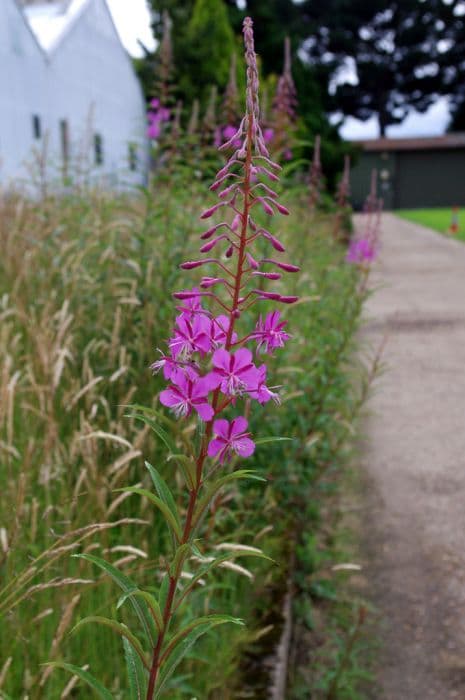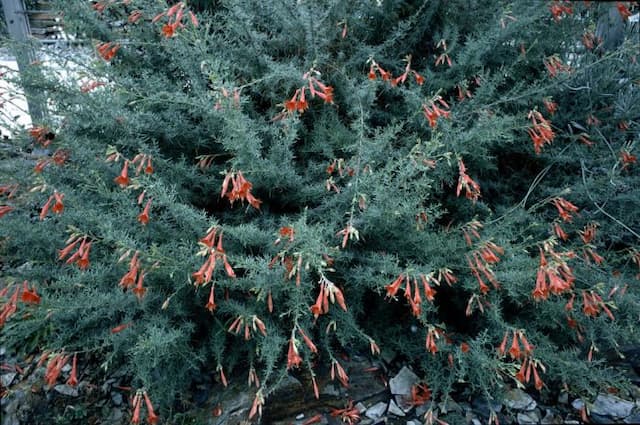Fuchsia Fuchsia 'Nice 'n' Easy' (d)

ABOUT
The Fuchsia 'Nice 'n' Easy' is a strikingly ornamental plant renowned for its distinctive and colorful flowers. The blossoms have a unique, elegant droop and are composed of a vibrant outer layer, which can be a combination of pink and purple hues, and a softer inner layer that often displays a lighter pink or violet tone. These bicolor petals create a stunning contrast that is visually appealing and draws the attention of garden admirers and pollinators alike. The flowers typically feature long, slender sepals that extend gracefully outward and upwards from the main body of the flower. Below these, the petal structure hangs down, creating a pendant or teardrop effect that is characteristic of the fuchsia plant. The stamens within these flowers are somewhat lengthy and protrude outward, adding an extra dash of detail and texture to the bloom. The overall shape of the fuchsia flower is reminiscent of a dancer's twirling skirt and is among the many reasons this plant is cherished by gardeners. In addition to its showy flowers, Fuchsia 'Nice 'n' Easy' has lush, green foliage that provides a plush backdrop for the floral display. The leaves are typically oval-shaped with a slight point at the tip and can have a subtle serration along the edges. This greenery contrasts well with the bold colors of the flowers and adds to the plant's robust and vibrant appearance. Each stem and branch arches and cascades, contributing to the plant's gentle and flowing aesthetic, which is familiar to those who enjoy the ornamental qualities of pendulous fuchsia varieties.
About this plant
 Names
NamesFamily
Onagraceae
Synonyms
Lady's Eardrops, Fuchsia, Hummingbird Fuchsia
Common names
Fuchsia 'Nice 'n' Easy' (d)
 Toxicity
ToxicityTo humans
Fuchsias, including the 'Nice 'n' Easy' variety, are generally considered non-toxic to humans. However, ingestion of any part of the plant is not advisable as individual sensitivity may vary, and consuming non-edible plants can sometimes cause mild gastrointestinal discomfort or allergic reactions in some people.
To pets
Fuchsias are also generally regarded as non-toxic to pets. This means that pets, including cats and dogs, are unlikely to experience severe poisoning symptoms after ingesting parts of the 'Nice 'n' Easy' fuchsia. Nevertheless, as with humans, individual animals may have different sensitivities, and ingestion can sometimes lead to mild gastrointestinal upset.
 Characteristics
CharacteristicsLife cycle
Perennials
Foliage type
Deciduous
Color of leaves
Green
Flower color
Pink
Height
2-3 feet (60-90 cm)
Spread
2-3 feet (60-90 cm)
Plant type
Shrub
Hardiness zones
9
Native area
Central and South America
Benefits
 General Benefits
General Benefits- Ornamental Appeal: Offers vibrant and attractive flowers that enhance the visual aesthetics of gardens and landscapes.
- Attracts Pollinators: Invites beneficial pollinators like bees, butterflies, and hummingbirds, helping to support local ecosystems.
- Versatility: Suitable for container gardening, hanging baskets, and can be grown as a shrub in the garden, fitting various landscaping designs.
- Extended Blooming Season: Blooms for a long period, typically from spring to fall, providing long-lasting color and interest.
- Shade Tolerance: Can thrive in partial shade, making it a great option for gardens with mixed light conditions.
- Easy Propagation: Can be easily propagated from cuttings, allowing gardeners to create new plants and share with others.
- Improves Garden Diversity: Adds variety to plant collections with its unique pendulous flower shapes and vivid colors.
- Moderate Maintenance: Requires a reasonable level of care, such as regular watering and occasional pruning, suitable for most gardeners.
- Resilience: Tolerates a range of climate conditions within its hardiness zones, demonstrating adaptability to different environments.
- Non-Invasive: Unlike some ornamentals, it typically does not spread aggressively, reducing maintenance and ecological concerns.
 Medical Properties
Medical PropertiesThis plant is not used for medical purposes.
 Air-purifying Qualities
Air-purifying QualitiesThis plant is not specifically known for air purifying qualities.
 Other Uses
Other Uses- Fuchsia leaves can be used to create a natural dye that imparts a subtle green color to fabrics or paper products.
- The nectar-rich flowers of fuchsia can be a source of food for hummingbird feeders.
- The berry-like fruits of some fuchsia varieties are edible and can be used to make jams, jellies, or pies.
- With its attractive blossoms, fuchsia can be incorporated into floral arrangements or bouquets.
- Fuchsia plants are sometimes used in butterfly gardens as they attract certain species, adding to biodiversity.
- Fuchsias can be planted in outdoor living walls or vertical gardens to add vibrant color and texture.
- When dried, fuchsia flowers can be added to potpourri mixes for their color and delicate structure.
- In some cultures, fuchsia flowers are symbolic and used in ceremonies or rituals to represent confiding love.
- The trailing habit of some fuchsia plants makes them suitable for hanging baskets, adding dimension to outdoor décor.
- Fuchsias can play a role in a sensory garden for the visually impaired with their distinctively shaped flowers and slight fragrance.
Interesting Facts
 Feng Shui
Feng ShuiThe Fuchsia is not used in Feng Shui practice.
 Zodiac Sign Compitability
Zodiac Sign CompitabilityThe Fuchsia is not used in astrology practice.
 Plant Symbolism
Plant Symbolism- Confiding Love: The hanging blossoms of fuchsia often symbolize confiding love. Their delicate and unique shape can be seen as an invitation to share secrets or intimate thoughts.
- Elegance and Grace: Fuchsia blooms with a graceful drape, representing elegance and poise. Their appearance in gardens and arrangements adds a touch of sophistication and beauty.
- Good Taste: The fuchsia flower is associated with good taste, not just aesthetically, but also in making choices and discerning quality in various aspects of life.
- Ambiguity and Contrasts: With petals that blend pink, purple, and other colors, fuchsias embody the concept of complexity and the juxtaposition of contrasting elements coming together harmoniously.
- Harmony and Balance: Despite their vibrant appearance, fuchsia flowers grow in a way that suggests balance and harmony with their surroundings, making them a symbol for these ideals in life.
 Water
WaterFuchsias, including the 'Nice 'n' Easy' variety, prefer consistent moisture but don't fare well in soggy soil. Ensure the plant is watered deeply and thoroughly when the top inch of soil feels dry to the touch, which might be twice a week in hotter seasons or once a week during cooler temperatures. Typically, this would be around 16-32 ounces of water per week, depending on the size of the plant and environmental conditions. During extremely hot periods, they may require more frequent watering to prevent wilting. Always avoid letting the fuchsia dry out completely, as this can lead to stress and leaf drop.
 Light
LightFuchsias, like 'Nice 'n' Easy,' thrive in bright, indirect light with some shelter from the strongest midday sun. They are perfect for hanging baskets or pots in a location that receives morning sunlight and afternoon shade. The ideal spot would be on a porch or under a tree that provides dappled light, ensuring they receive sufficient light without exposure to intense sun which can damage the foliage.
 Temperature
TemperatureFuchsias, including 'Nice 'n' Easy,' prefer cooler temperature conditions and perform best in a range between 55°F and 75°F. They are sensitive to high heat, and temperatures above 76°F can cause heat stress. These plants can tolerate temperatures down to around 40°F but should be protected from frost, as temperatures near 32°F or below can be fatal.
 Pruning
PruningPruning is essential for fuchsias, including 'Nice 'n' Easy,' to maintain a bushy, well-shaped plant and encourage abundant blooms. Prune in late winter or early spring before new growth begins, removing dead or weak branches and shaping as desired. Additionally, pinch out the tips of stems during the growing season to promote branching and more flowers. Pruning is typically done once a year, but regular pinching can be performed throughout the growing season.
 Cleaning
CleaningAs needed
 Soil
SoilFuchsia 'Nice 'n' Easy' thrives in a well-draining, fertile soil mix with added peat moss and perlite. The best pH for this fuchsia is slightly acidic to neutral, around 6.0-7.0.
 Repotting
RepottingFuchsia 'Nice 'n' Easy' should be repotted every 2-3 years, or when it outgrows its current pot, to provide fresh nutrients and encourage growth.
 Humidity & Misting
Humidity & MistingFuchsia 'Nice 'n' Easy' prefers high humidity levels, ideally around 60-70% for optimal growth conditions.
 Suitable locations
Suitable locationsIndoor
Keep in bright, indirect light, and maintain high humidity.
Outdoor
Protect from midday sun, place in a sheltered area.
Hardiness zone
10-11 USDA
 Life cycle
Life cycleFuchsia 'Nice 'n' Easy', also known just as Fuchsia, begins its life cycle when a seed germinates, typically in warm and moist conditions, giving rise to a small seedling. As it grows, the seedling develops into a young plant with a set of true leaves, and with proper care, including adequate water, light, and nutrient supplies, it matures into a bushy shrub. This perennial plant then enters a flowering phase where it produces distinctive hanging, tubular flowers, often in shades of pink, purple, and white, which are pollinated by birds and insects. After pollination, it sets fruit in the form of small berries that contain seeds, completing the reproductive cycle. During colder months, fuchsia may enter a dormancy period where growth slows down, and it may lose leaves depending on the climate. With the return of warmer temperatures, the plant resumes growth and begins the cycle anew.
 Propogation
PropogationPropogation time
Spring-Early Summer
Propogation: Fuchsia 'Nice 'n' Easy', often referred to simply as fuchsia, is commonly propagated through softwood cuttings. This method is quite popular due to its effectiveness and simplicity. Ideally, the best time to take cuttings is late spring or early summer when the plant is actively growing and the shoots are neither too young nor too woody. To propagate by cuttings, one starts by selecting a healthy, non-flowering shoot and cutting a 3 to 4-inch (approximately 7.5 to 10 centimeters) section just below a leaf joint. The lower leaves are removed, and the cut end is dipped in a rooting hormone to stimulate root growth. The prepared cutting is then placed into a pot filled with a mix of peat and perlite, ensuring that the leaf nodes are buried where new roots are expected to emerge. The pot should be kept in a warm location with indirect light and maintained slightly moist until the cutting has rooted, which generally takes a few weeks.









